Human Resource Management Report: BT Plc HRM Practices Analysis
VerifiedAdded on 2020/07/22
|18
|4920
|131
Report
AI Summary
This report provides a comprehensive overview of human resource management (HRM) functions within an organization, with a specific focus on recruitment, selection, and employee relations. It examines the core functions of HRM, including recruitment and selection processes, orientation, maintaining good working conditions, managing employee relations, and training and development. The report uses British Telecommunication Plc. (BT Plc) as a case study, analyzing its HRM practices, including employee empowerment, teamwork, compensation, performance appraisals, and employee security. It explores the benefits of HRM for both employers and employees, highlighting how effective HRM practices can enhance employee performance, productivity, and overall organizational success. The report also discusses the strengths and weaknesses of different recruitment and selection approaches, including internal and external sources, and the importance of employee relations in influencing HRM decision-making. Furthermore, the report covers key elements of employee legislation and their impact on the decision-making process. Finally, the report provides practical applications of HRM practices in a work-related context, offering insights into how organizations can optimize their HRM strategies for improved outcomes.
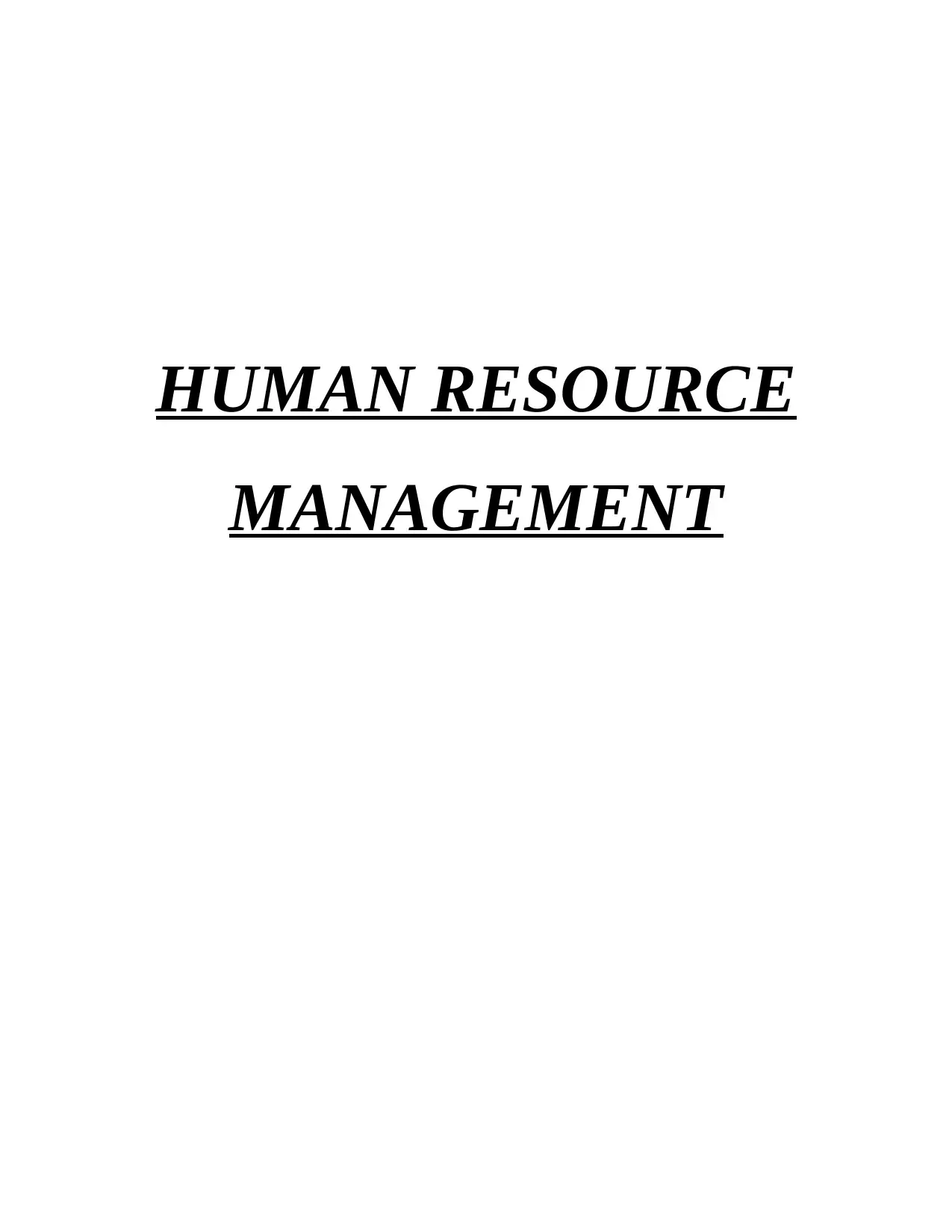
HUMAN RESOURCE
MANAGEMENT
MANAGEMENT
Paraphrase This Document
Need a fresh take? Get an instant paraphrase of this document with our AI Paraphraser

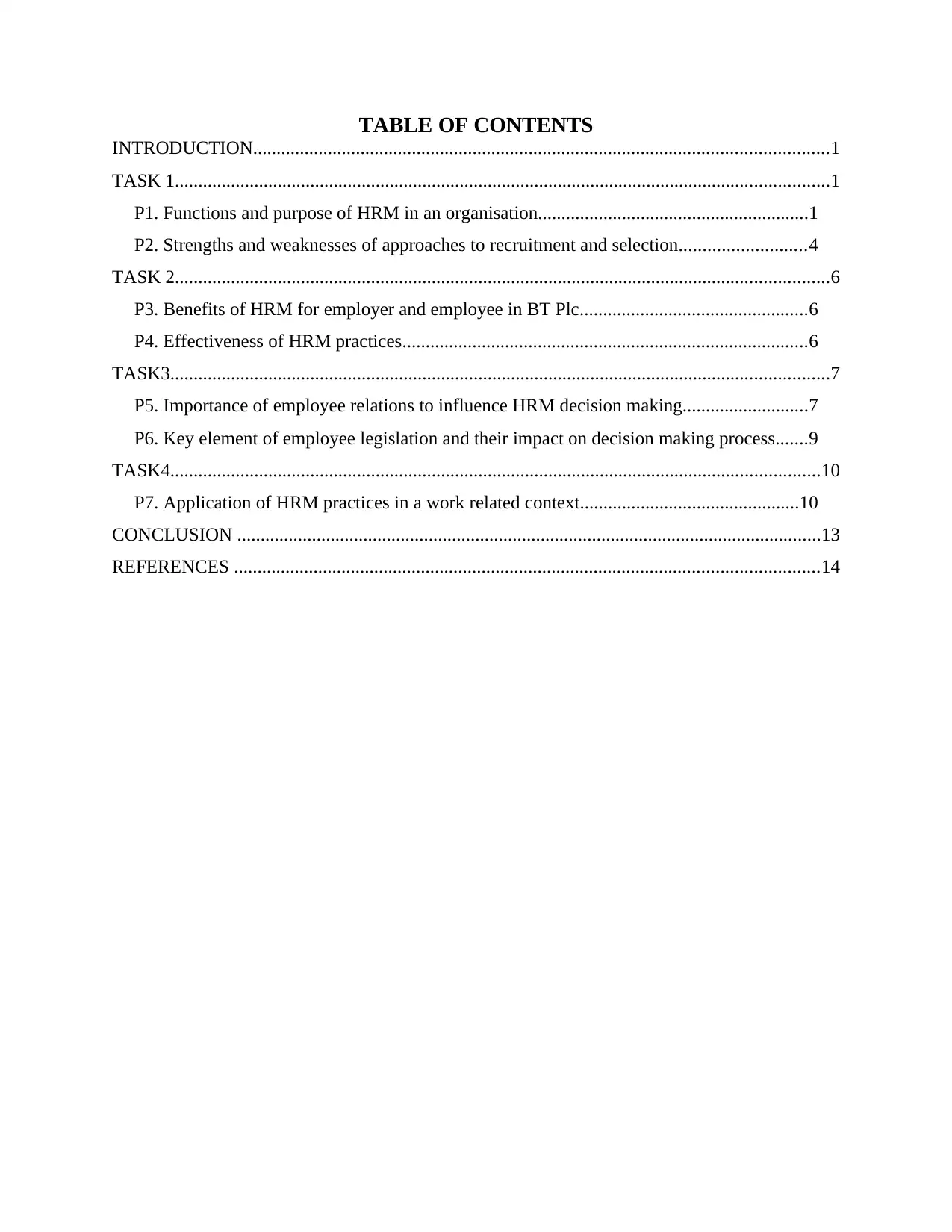
TABLE OF CONTENTS
INTRODUCTION...........................................................................................................................1
TASK 1............................................................................................................................................1
P1. Functions and purpose of HRM in an organisation..........................................................1
P2. Strengths and weaknesses of approaches to recruitment and selection...........................4
TASK 2............................................................................................................................................6
P3. Benefits of HRM for employer and employee in BT Plc.................................................6
P4. Effectiveness of HRM practices.......................................................................................6
TASK3.............................................................................................................................................7
P5. Importance of employee relations to influence HRM decision making...........................7
P6. Key element of employee legislation and their impact on decision making process.......9
TASK4...........................................................................................................................................10
P7. Application of HRM practices in a work related context...............................................10
CONCLUSION .............................................................................................................................13
REFERENCES .............................................................................................................................14
INTRODUCTION...........................................................................................................................1
TASK 1............................................................................................................................................1
P1. Functions and purpose of HRM in an organisation..........................................................1
P2. Strengths and weaknesses of approaches to recruitment and selection...........................4
TASK 2............................................................................................................................................6
P3. Benefits of HRM for employer and employee in BT Plc.................................................6
P4. Effectiveness of HRM practices.......................................................................................6
TASK3.............................................................................................................................................7
P5. Importance of employee relations to influence HRM decision making...........................7
P6. Key element of employee legislation and their impact on decision making process.......9
TASK4...........................................................................................................................................10
P7. Application of HRM practices in a work related context...............................................10
CONCLUSION .............................................................................................................................13
REFERENCES .............................................................................................................................14
⊘ This is a preview!⊘
Do you want full access?
Subscribe today to unlock all pages.

Trusted by 1+ million students worldwide
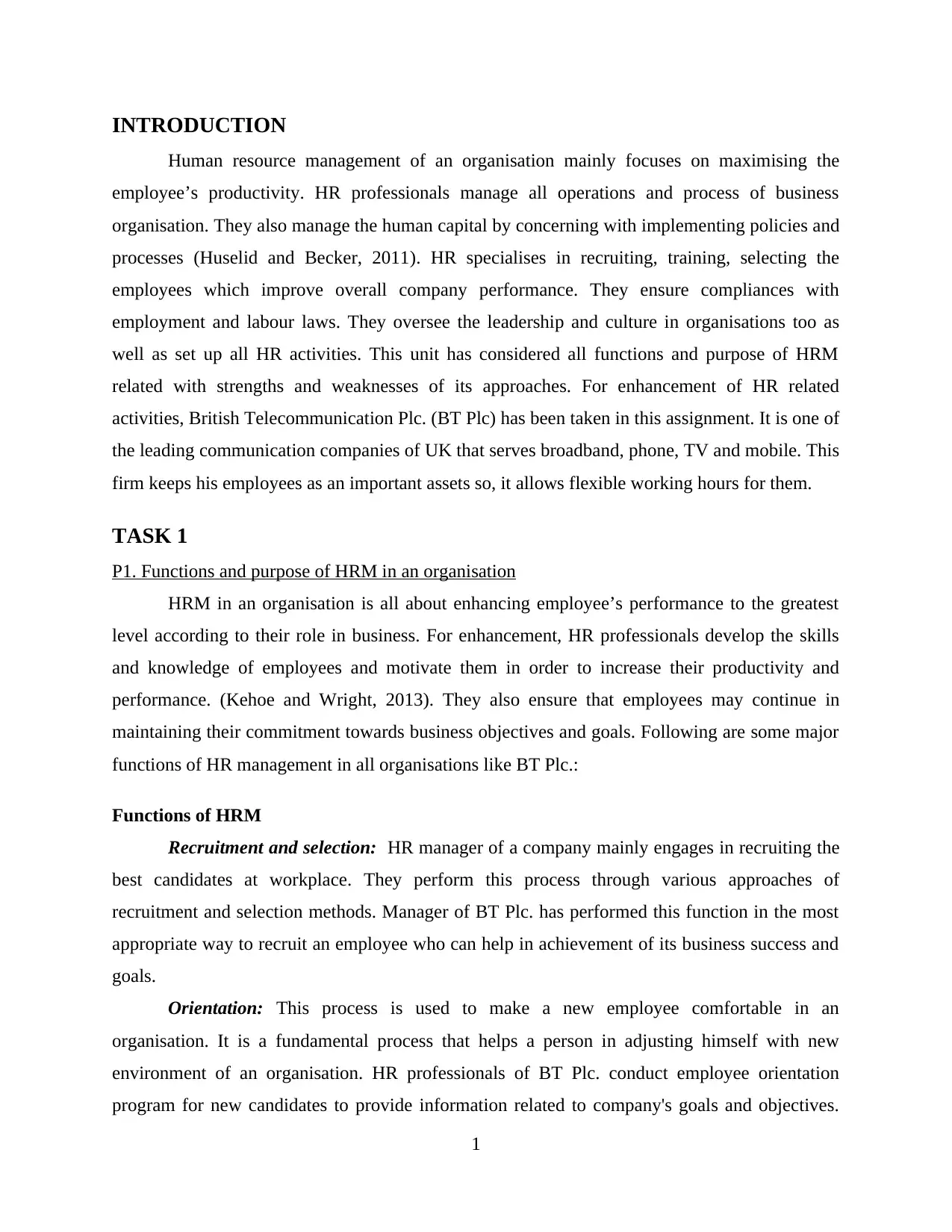
INTRODUCTION
Human resource management of an organisation mainly focuses on maximising the
employee’s productivity. HR professionals manage all operations and process of business
organisation. They also manage the human capital by concerning with implementing policies and
processes (Huselid and Becker, 2011). HR specialises in recruiting, training, selecting the
employees which improve overall company performance. They ensure compliances with
employment and labour laws. They oversee the leadership and culture in organisations too as
well as set up all HR activities. This unit has considered all functions and purpose of HRM
related with strengths and weaknesses of its approaches. For enhancement of HR related
activities, British Telecommunication Plc. (BT Plc) has been taken in this assignment. It is one of
the leading communication companies of UK that serves broadband, phone, TV and mobile. This
firm keeps his employees as an important assets so, it allows flexible working hours for them.
TASK 1
P1. Functions and purpose of HRM in an organisation
HRM in an organisation is all about enhancing employee’s performance to the greatest
level according to their role in business. For enhancement, HR professionals develop the skills
and knowledge of employees and motivate them in order to increase their productivity and
performance. (Kehoe and Wright, 2013). They also ensure that employees may continue in
maintaining their commitment towards business objectives and goals. Following are some major
functions of HR management in all organisations like BT Plc.:
Functions of HRM
Recruitment and selection: HR manager of a company mainly engages in recruiting the
best candidates at workplace. They perform this process through various approaches of
recruitment and selection methods. Manager of BT Plc. has performed this function in the most
appropriate way to recruit an employee who can help in achievement of its business success and
goals.
Orientation: This process is used to make a new employee comfortable in an
organisation. It is a fundamental process that helps a person in adjusting himself with new
environment of an organisation. HR professionals of BT Plc. conduct employee orientation
program for new candidates to provide information related to company's goals and objectives.
1
Human resource management of an organisation mainly focuses on maximising the
employee’s productivity. HR professionals manage all operations and process of business
organisation. They also manage the human capital by concerning with implementing policies and
processes (Huselid and Becker, 2011). HR specialises in recruiting, training, selecting the
employees which improve overall company performance. They ensure compliances with
employment and labour laws. They oversee the leadership and culture in organisations too as
well as set up all HR activities. This unit has considered all functions and purpose of HRM
related with strengths and weaknesses of its approaches. For enhancement of HR related
activities, British Telecommunication Plc. (BT Plc) has been taken in this assignment. It is one of
the leading communication companies of UK that serves broadband, phone, TV and mobile. This
firm keeps his employees as an important assets so, it allows flexible working hours for them.
TASK 1
P1. Functions and purpose of HRM in an organisation
HRM in an organisation is all about enhancing employee’s performance to the greatest
level according to their role in business. For enhancement, HR professionals develop the skills
and knowledge of employees and motivate them in order to increase their productivity and
performance. (Kehoe and Wright, 2013). They also ensure that employees may continue in
maintaining their commitment towards business objectives and goals. Following are some major
functions of HR management in all organisations like BT Plc.:
Functions of HRM
Recruitment and selection: HR manager of a company mainly engages in recruiting the
best candidates at workplace. They perform this process through various approaches of
recruitment and selection methods. Manager of BT Plc. has performed this function in the most
appropriate way to recruit an employee who can help in achievement of its business success and
goals.
Orientation: This process is used to make a new employee comfortable in an
organisation. It is a fundamental process that helps a person in adjusting himself with new
environment of an organisation. HR professionals of BT Plc. conduct employee orientation
program for new candidates to provide information related to company's goals and objectives.
1
Paraphrase This Document
Need a fresh take? Get an instant paraphrase of this document with our AI Paraphraser
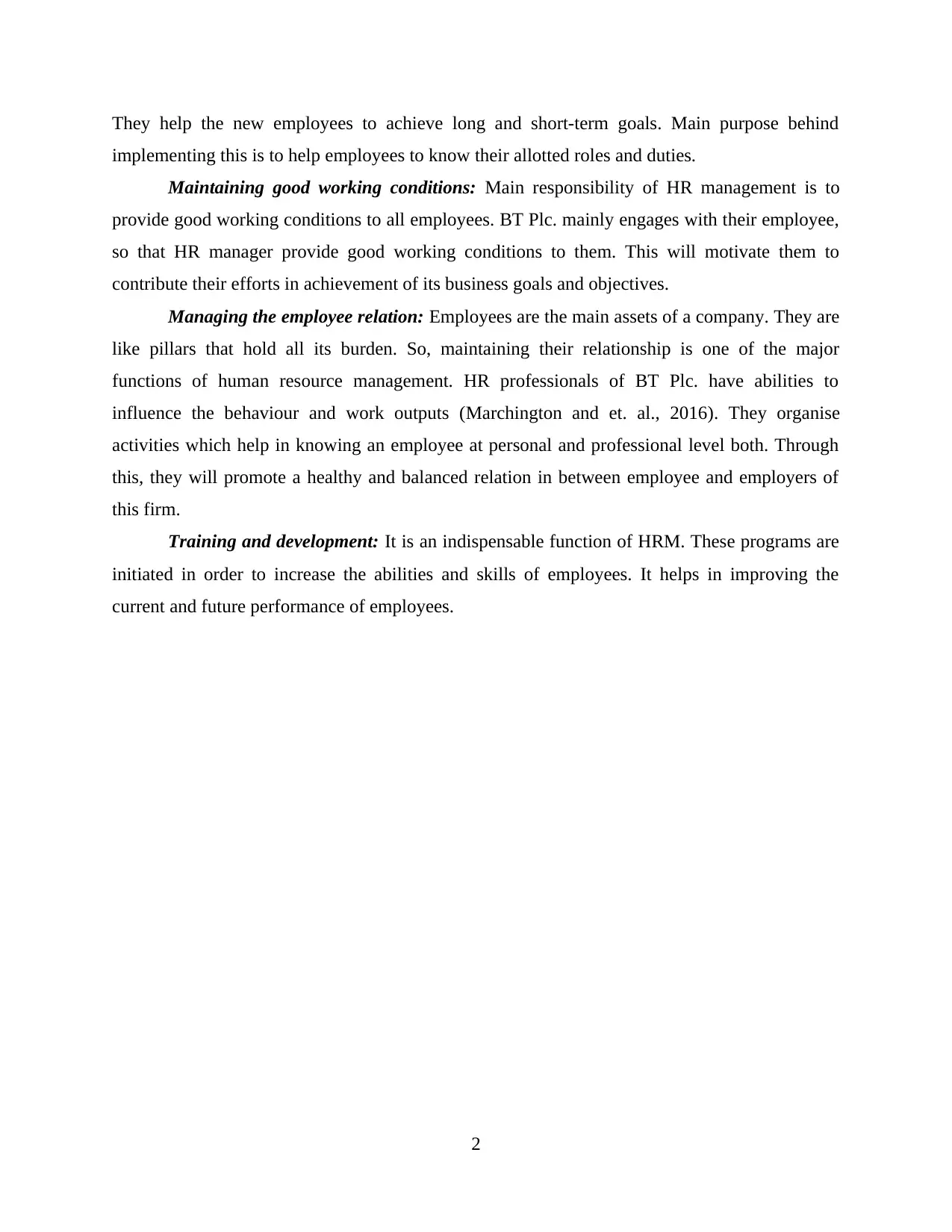
They help the new employees to achieve long and short-term goals. Main purpose behind
implementing this is to help employees to know their allotted roles and duties.
Maintaining good working conditions: Main responsibility of HR management is to
provide good working conditions to all employees. BT Plc. mainly engages with their employee,
so that HR manager provide good working conditions to them. This will motivate them to
contribute their efforts in achievement of its business goals and objectives.
Managing the employee relation: Employees are the main assets of a company. They are
like pillars that hold all its burden. So, maintaining their relationship is one of the major
functions of human resource management. HR professionals of BT Plc. have abilities to
influence the behaviour and work outputs (Marchington and et. al., 2016). They organise
activities which help in knowing an employee at personal and professional level both. Through
this, they will promote a healthy and balanced relation in between employee and employers of
this firm.
Training and development: It is an indispensable function of HRM. These programs are
initiated in order to increase the abilities and skills of employees. It helps in improving the
current and future performance of employees.
2
implementing this is to help employees to know their allotted roles and duties.
Maintaining good working conditions: Main responsibility of HR management is to
provide good working conditions to all employees. BT Plc. mainly engages with their employee,
so that HR manager provide good working conditions to them. This will motivate them to
contribute their efforts in achievement of its business goals and objectives.
Managing the employee relation: Employees are the main assets of a company. They are
like pillars that hold all its burden. So, maintaining their relationship is one of the major
functions of human resource management. HR professionals of BT Plc. have abilities to
influence the behaviour and work outputs (Marchington and et. al., 2016). They organise
activities which help in knowing an employee at personal and professional level both. Through
this, they will promote a healthy and balanced relation in between employee and employers of
this firm.
Training and development: It is an indispensable function of HRM. These programs are
initiated in order to increase the abilities and skills of employees. It helps in improving the
current and future performance of employees.
2
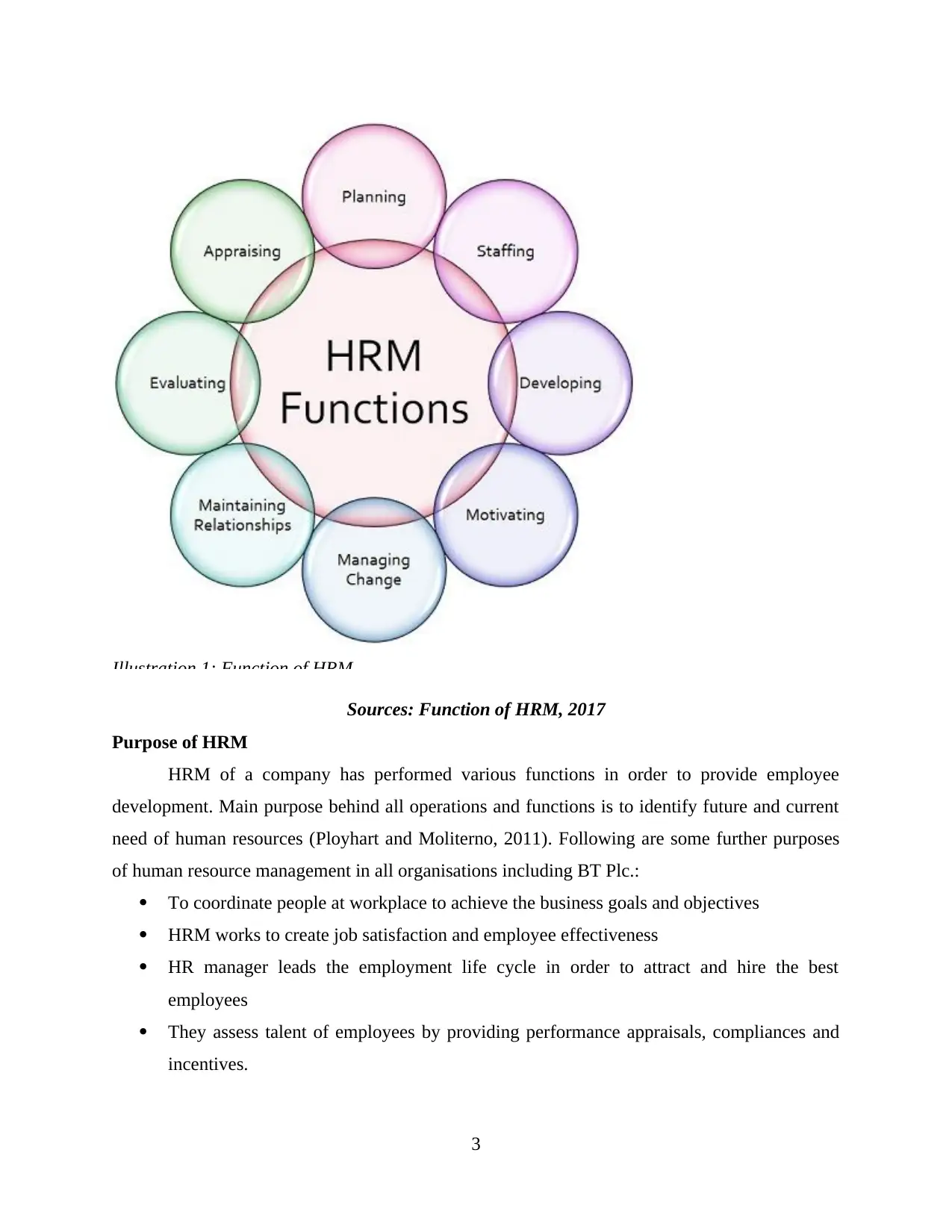
Illustration 1: Function of HRM
Sources: Function of HRM, 2017
Purpose of HRM
HRM of a company has performed various functions in order to provide employee
development. Main purpose behind all operations and functions is to identify future and current
need of human resources (Ployhart and Moliterno, 2011). Following are some further purposes
of human resource management in all organisations including BT Plc.:
To coordinate people at workplace to achieve the business goals and objectives
HRM works to create job satisfaction and employee effectiveness
HR manager leads the employment life cycle in order to attract and hire the best
employees
They assess talent of employees by providing performance appraisals, compliances and
incentives.
3
Sources: Function of HRM, 2017
Purpose of HRM
HRM of a company has performed various functions in order to provide employee
development. Main purpose behind all operations and functions is to identify future and current
need of human resources (Ployhart and Moliterno, 2011). Following are some further purposes
of human resource management in all organisations including BT Plc.:
To coordinate people at workplace to achieve the business goals and objectives
HRM works to create job satisfaction and employee effectiveness
HR manager leads the employment life cycle in order to attract and hire the best
employees
They assess talent of employees by providing performance appraisals, compliances and
incentives.
3
⊘ This is a preview!⊘
Do you want full access?
Subscribe today to unlock all pages.

Trusted by 1+ million students worldwide
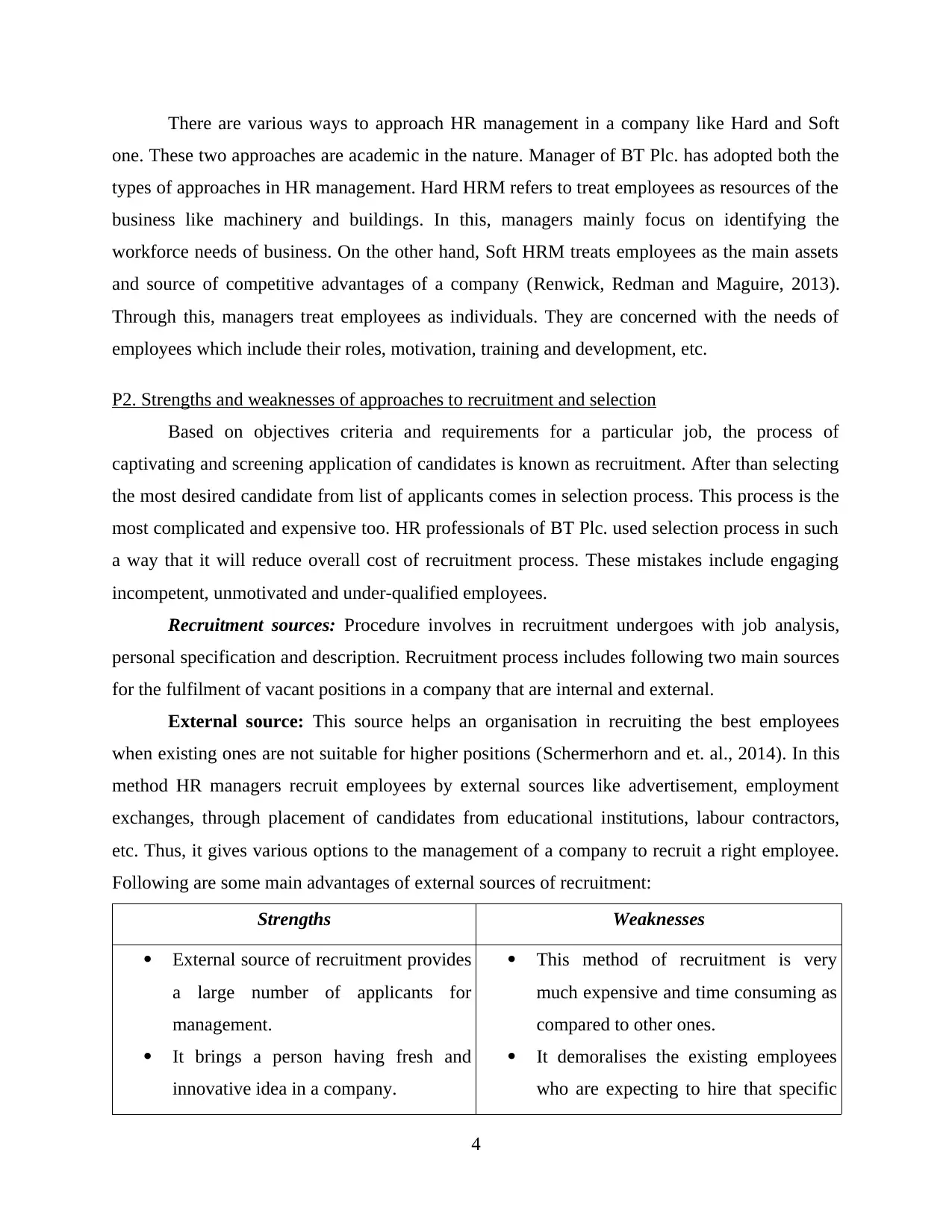
There are various ways to approach HR management in a company like Hard and Soft
one. These two approaches are academic in the nature. Manager of BT Plc. has adopted both the
types of approaches in HR management. Hard HRM refers to treat employees as resources of the
business like machinery and buildings. In this, managers mainly focus on identifying the
workforce needs of business. On the other hand, Soft HRM treats employees as the main assets
and source of competitive advantages of a company (Renwick, Redman and Maguire, 2013).
Through this, managers treat employees as individuals. They are concerned with the needs of
employees which include their roles, motivation, training and development, etc.
P2. Strengths and weaknesses of approaches to recruitment and selection
Based on objectives criteria and requirements for a particular job, the process of
captivating and screening application of candidates is known as recruitment. After than selecting
the most desired candidate from list of applicants comes in selection process. This process is the
most complicated and expensive too. HR professionals of BT Plc. used selection process in such
a way that it will reduce overall cost of recruitment process. These mistakes include engaging
incompetent, unmotivated and under-qualified employees.
Recruitment sources: Procedure involves in recruitment undergoes with job analysis,
personal specification and description. Recruitment process includes following two main sources
for the fulfilment of vacant positions in a company that are internal and external.
External source: This source helps an organisation in recruiting the best employees
when existing ones are not suitable for higher positions (Schermerhorn and et. al., 2014). In this
method HR managers recruit employees by external sources like advertisement, employment
exchanges, through placement of candidates from educational institutions, labour contractors,
etc. Thus, it gives various options to the management of a company to recruit a right employee.
Following are some main advantages of external sources of recruitment:
Strengths Weaknesses
External source of recruitment provides
a large number of applicants for
management.
It brings a person having fresh and
innovative idea in a company.
This method of recruitment is very
much expensive and time consuming as
compared to other ones.
It demoralises the existing employees
who are expecting to hire that specific
4
one. These two approaches are academic in the nature. Manager of BT Plc. has adopted both the
types of approaches in HR management. Hard HRM refers to treat employees as resources of the
business like machinery and buildings. In this, managers mainly focus on identifying the
workforce needs of business. On the other hand, Soft HRM treats employees as the main assets
and source of competitive advantages of a company (Renwick, Redman and Maguire, 2013).
Through this, managers treat employees as individuals. They are concerned with the needs of
employees which include their roles, motivation, training and development, etc.
P2. Strengths and weaknesses of approaches to recruitment and selection
Based on objectives criteria and requirements for a particular job, the process of
captivating and screening application of candidates is known as recruitment. After than selecting
the most desired candidate from list of applicants comes in selection process. This process is the
most complicated and expensive too. HR professionals of BT Plc. used selection process in such
a way that it will reduce overall cost of recruitment process. These mistakes include engaging
incompetent, unmotivated and under-qualified employees.
Recruitment sources: Procedure involves in recruitment undergoes with job analysis,
personal specification and description. Recruitment process includes following two main sources
for the fulfilment of vacant positions in a company that are internal and external.
External source: This source helps an organisation in recruiting the best employees
when existing ones are not suitable for higher positions (Schermerhorn and et. al., 2014). In this
method HR managers recruit employees by external sources like advertisement, employment
exchanges, through placement of candidates from educational institutions, labour contractors,
etc. Thus, it gives various options to the management of a company to recruit a right employee.
Following are some main advantages of external sources of recruitment:
Strengths Weaknesses
External source of recruitment provides
a large number of applicants for
management.
It brings a person having fresh and
innovative idea in a company.
This method of recruitment is very
much expensive and time consuming as
compared to other ones.
It demoralises the existing employees
who are expecting to hire that specific
4
Paraphrase This Document
Need a fresh take? Get an instant paraphrase of this document with our AI Paraphraser
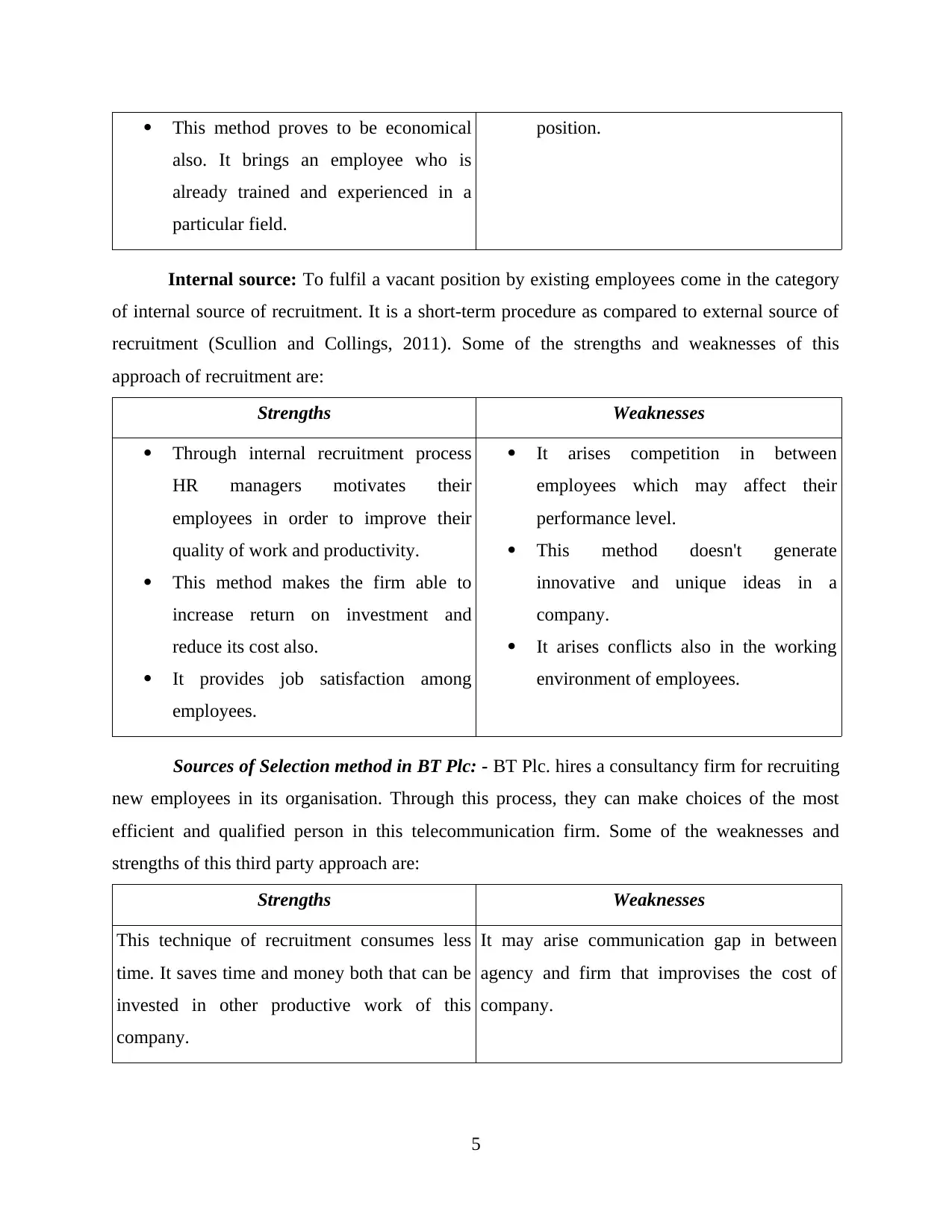
This method proves to be economical
also. It brings an employee who is
already trained and experienced in a
particular field.
position.
Internal source: To fulfil a vacant position by existing employees come in the category
of internal source of recruitment. It is a short-term procedure as compared to external source of
recruitment (Scullion and Collings, 2011). Some of the strengths and weaknesses of this
approach of recruitment are:
Strengths Weaknesses
Through internal recruitment process
HR managers motivates their
employees in order to improve their
quality of work and productivity.
This method makes the firm able to
increase return on investment and
reduce its cost also.
It provides job satisfaction among
employees.
It arises competition in between
employees which may affect their
performance level.
This method doesn't generate
innovative and unique ideas in a
company.
It arises conflicts also in the working
environment of employees.
Sources of Selection method in BT Plc: - BT Plc. hires a consultancy firm for recruiting
new employees in its organisation. Through this process, they can make choices of the most
efficient and qualified person in this telecommunication firm. Some of the weaknesses and
strengths of this third party approach are:
Strengths Weaknesses
This technique of recruitment consumes less
time. It saves time and money both that can be
invested in other productive work of this
company.
It may arise communication gap in between
agency and firm that improvises the cost of
company.
5
also. It brings an employee who is
already trained and experienced in a
particular field.
position.
Internal source: To fulfil a vacant position by existing employees come in the category
of internal source of recruitment. It is a short-term procedure as compared to external source of
recruitment (Scullion and Collings, 2011). Some of the strengths and weaknesses of this
approach of recruitment are:
Strengths Weaknesses
Through internal recruitment process
HR managers motivates their
employees in order to improve their
quality of work and productivity.
This method makes the firm able to
increase return on investment and
reduce its cost also.
It provides job satisfaction among
employees.
It arises competition in between
employees which may affect their
performance level.
This method doesn't generate
innovative and unique ideas in a
company.
It arises conflicts also in the working
environment of employees.
Sources of Selection method in BT Plc: - BT Plc. hires a consultancy firm for recruiting
new employees in its organisation. Through this process, they can make choices of the most
efficient and qualified person in this telecommunication firm. Some of the weaknesses and
strengths of this third party approach are:
Strengths Weaknesses
This technique of recruitment consumes less
time. It saves time and money both that can be
invested in other productive work of this
company.
It may arise communication gap in between
agency and firm that improvises the cost of
company.
5
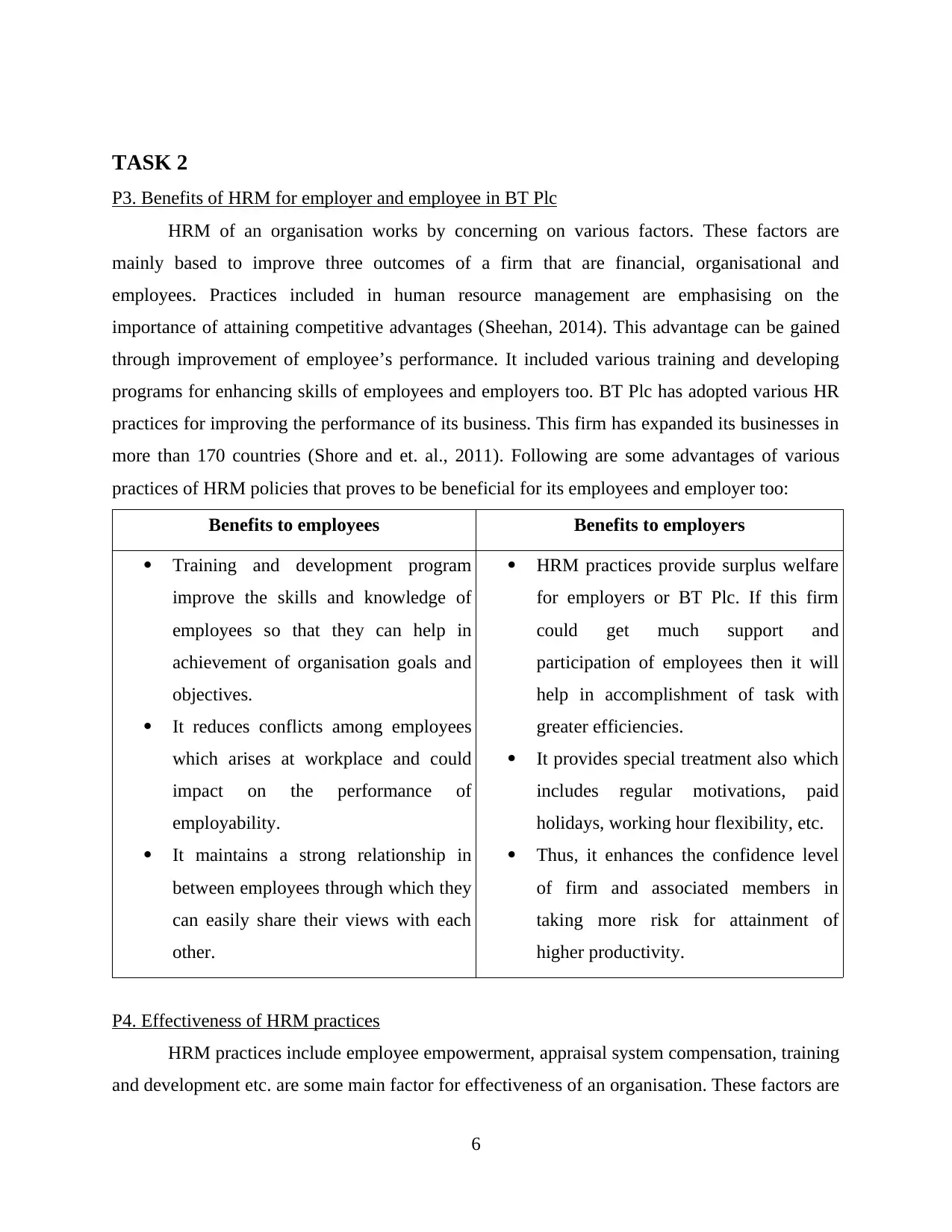
TASK 2
P3. Benefits of HRM for employer and employee in BT Plc
HRM of an organisation works by concerning on various factors. These factors are
mainly based to improve three outcomes of a firm that are financial, organisational and
employees. Practices included in human resource management are emphasising on the
importance of attaining competitive advantages (Sheehan, 2014). This advantage can be gained
through improvement of employee’s performance. It included various training and developing
programs for enhancing skills of employees and employers too. BT Plc has adopted various HR
practices for improving the performance of its business. This firm has expanded its businesses in
more than 170 countries (Shore and et. al., 2011). Following are some advantages of various
practices of HRM policies that proves to be beneficial for its employees and employer too:
Benefits to employees Benefits to employers
Training and development program
improve the skills and knowledge of
employees so that they can help in
achievement of organisation goals and
objectives.
It reduces conflicts among employees
which arises at workplace and could
impact on the performance of
employability.
It maintains a strong relationship in
between employees through which they
can easily share their views with each
other.
HRM practices provide surplus welfare
for employers or BT Plc. If this firm
could get much support and
participation of employees then it will
help in accomplishment of task with
greater efficiencies.
It provides special treatment also which
includes regular motivations, paid
holidays, working hour flexibility, etc.
Thus, it enhances the confidence level
of firm and associated members in
taking more risk for attainment of
higher productivity.
P4. Effectiveness of HRM practices
HRM practices include employee empowerment, appraisal system compensation, training
and development etc. are some main factor for effectiveness of an organisation. These factors are
6
P3. Benefits of HRM for employer and employee in BT Plc
HRM of an organisation works by concerning on various factors. These factors are
mainly based to improve three outcomes of a firm that are financial, organisational and
employees. Practices included in human resource management are emphasising on the
importance of attaining competitive advantages (Sheehan, 2014). This advantage can be gained
through improvement of employee’s performance. It included various training and developing
programs for enhancing skills of employees and employers too. BT Plc has adopted various HR
practices for improving the performance of its business. This firm has expanded its businesses in
more than 170 countries (Shore and et. al., 2011). Following are some advantages of various
practices of HRM policies that proves to be beneficial for its employees and employer too:
Benefits to employees Benefits to employers
Training and development program
improve the skills and knowledge of
employees so that they can help in
achievement of organisation goals and
objectives.
It reduces conflicts among employees
which arises at workplace and could
impact on the performance of
employability.
It maintains a strong relationship in
between employees through which they
can easily share their views with each
other.
HRM practices provide surplus welfare
for employers or BT Plc. If this firm
could get much support and
participation of employees then it will
help in accomplishment of task with
greater efficiencies.
It provides special treatment also which
includes regular motivations, paid
holidays, working hour flexibility, etc.
Thus, it enhances the confidence level
of firm and associated members in
taking more risk for attainment of
higher productivity.
P4. Effectiveness of HRM practices
HRM practices include employee empowerment, appraisal system compensation, training
and development etc. are some main factor for effectiveness of an organisation. These factors are
6
⊘ This is a preview!⊘
Do you want full access?
Subscribe today to unlock all pages.

Trusted by 1+ million students worldwide
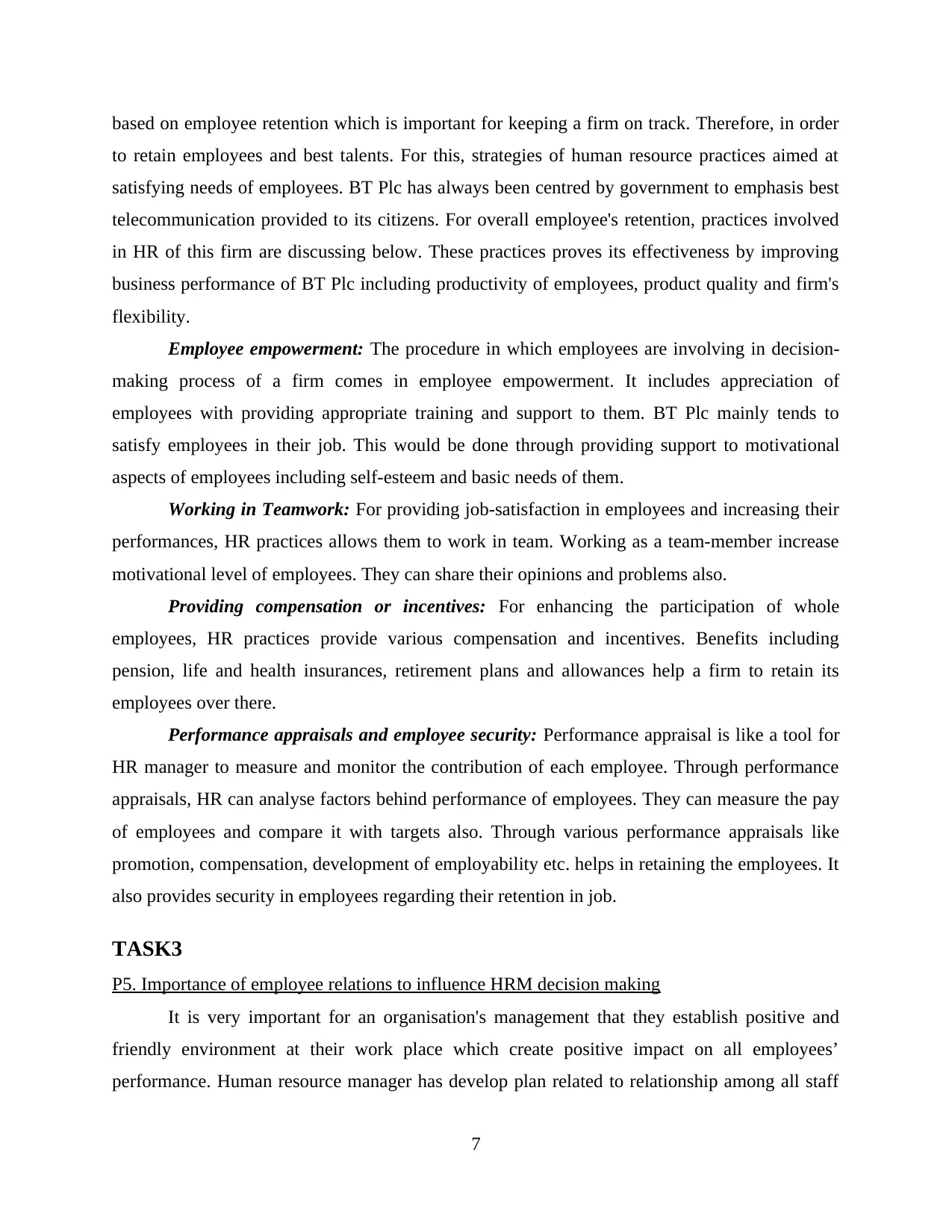
based on employee retention which is important for keeping a firm on track. Therefore, in order
to retain employees and best talents. For this, strategies of human resource practices aimed at
satisfying needs of employees. BT Plc has always been centred by government to emphasis best
telecommunication provided to its citizens. For overall employee's retention, practices involved
in HR of this firm are discussing below. These practices proves its effectiveness by improving
business performance of BT Plc including productivity of employees, product quality and firm's
flexibility.
Employee empowerment: The procedure in which employees are involving in decision-
making process of a firm comes in employee empowerment. It includes appreciation of
employees with providing appropriate training and support to them. BT Plc mainly tends to
satisfy employees in their job. This would be done through providing support to motivational
aspects of employees including self-esteem and basic needs of them.
Working in Teamwork: For providing job-satisfaction in employees and increasing their
performances, HR practices allows them to work in team. Working as a team-member increase
motivational level of employees. They can share their opinions and problems also.
Providing compensation or incentives: For enhancing the participation of whole
employees, HR practices provide various compensation and incentives. Benefits including
pension, life and health insurances, retirement plans and allowances help a firm to retain its
employees over there.
Performance appraisals and employee security: Performance appraisal is like a tool for
HR manager to measure and monitor the contribution of each employee. Through performance
appraisals, HR can analyse factors behind performance of employees. They can measure the pay
of employees and compare it with targets also. Through various performance appraisals like
promotion, compensation, development of employability etc. helps in retaining the employees. It
also provides security in employees regarding their retention in job.
TASK3
P5. Importance of employee relations to influence HRM decision making
It is very important for an organisation's management that they establish positive and
friendly environment at their work place which create positive impact on all employees’
performance. Human resource manager has develop plan related to relationship among all staff
7
to retain employees and best talents. For this, strategies of human resource practices aimed at
satisfying needs of employees. BT Plc has always been centred by government to emphasis best
telecommunication provided to its citizens. For overall employee's retention, practices involved
in HR of this firm are discussing below. These practices proves its effectiveness by improving
business performance of BT Plc including productivity of employees, product quality and firm's
flexibility.
Employee empowerment: The procedure in which employees are involving in decision-
making process of a firm comes in employee empowerment. It includes appreciation of
employees with providing appropriate training and support to them. BT Plc mainly tends to
satisfy employees in their job. This would be done through providing support to motivational
aspects of employees including self-esteem and basic needs of them.
Working in Teamwork: For providing job-satisfaction in employees and increasing their
performances, HR practices allows them to work in team. Working as a team-member increase
motivational level of employees. They can share their opinions and problems also.
Providing compensation or incentives: For enhancing the participation of whole
employees, HR practices provide various compensation and incentives. Benefits including
pension, life and health insurances, retirement plans and allowances help a firm to retain its
employees over there.
Performance appraisals and employee security: Performance appraisal is like a tool for
HR manager to measure and monitor the contribution of each employee. Through performance
appraisals, HR can analyse factors behind performance of employees. They can measure the pay
of employees and compare it with targets also. Through various performance appraisals like
promotion, compensation, development of employability etc. helps in retaining the employees. It
also provides security in employees regarding their retention in job.
TASK3
P5. Importance of employee relations to influence HRM decision making
It is very important for an organisation's management that they establish positive and
friendly environment at their work place which create positive impact on all employees’
performance. Human resource manager has develop plan related to relationship among all staff
7
Paraphrase This Document
Need a fresh take? Get an instant paraphrase of this document with our AI Paraphraser
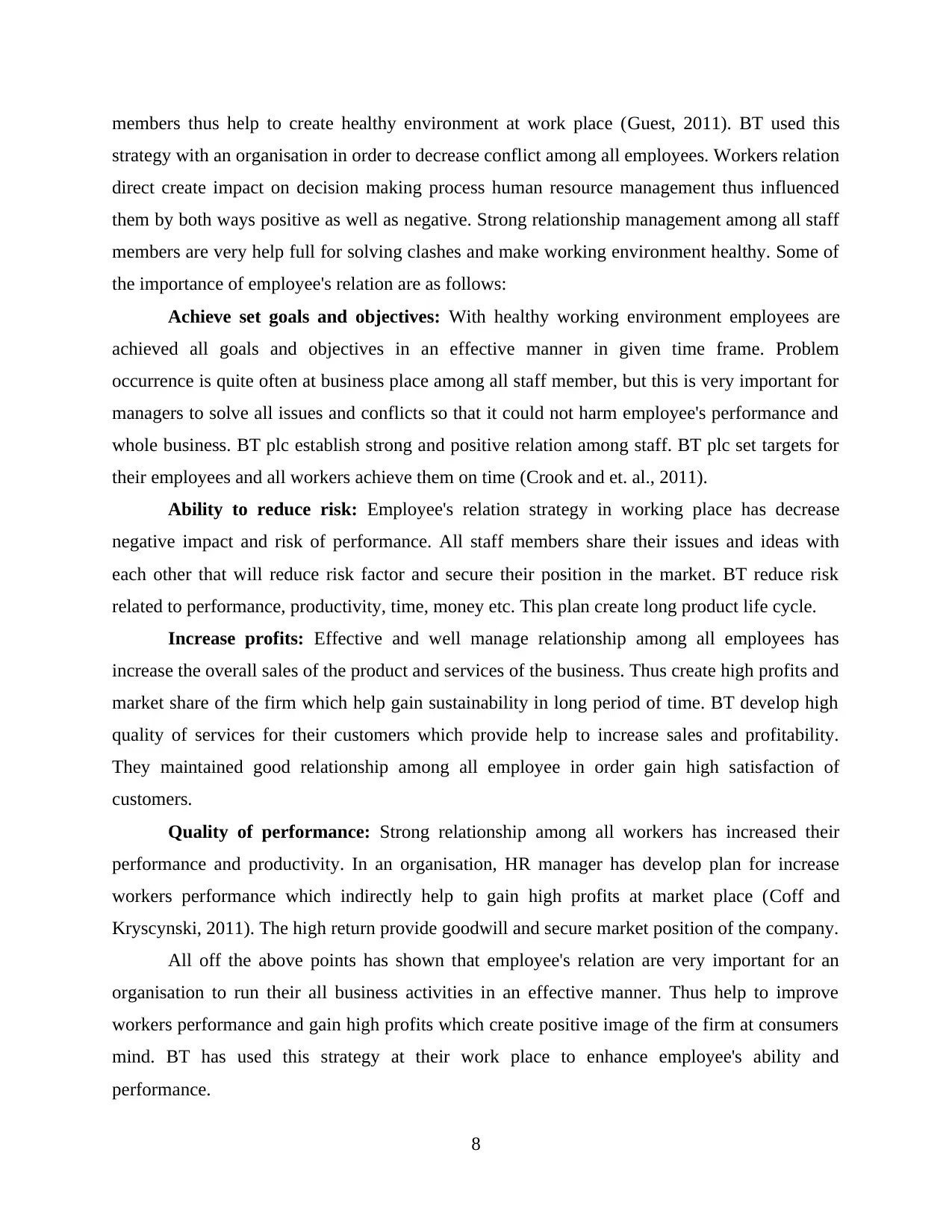
members thus help to create healthy environment at work place (Guest, 2011). BT used this
strategy with an organisation in order to decrease conflict among all employees. Workers relation
direct create impact on decision making process human resource management thus influenced
them by both ways positive as well as negative. Strong relationship management among all staff
members are very help full for solving clashes and make working environment healthy. Some of
the importance of employee's relation are as follows:
Achieve set goals and objectives: With healthy working environment employees are
achieved all goals and objectives in an effective manner in given time frame. Problem
occurrence is quite often at business place among all staff member, but this is very important for
managers to solve all issues and conflicts so that it could not harm employee's performance and
whole business. BT plc establish strong and positive relation among staff. BT plc set targets for
their employees and all workers achieve them on time (Crook and et. al., 2011).
Ability to reduce risk: Employee's relation strategy in working place has decrease
negative impact and risk of performance. All staff members share their issues and ideas with
each other that will reduce risk factor and secure their position in the market. BT reduce risk
related to performance, productivity, time, money etc. This plan create long product life cycle.
Increase profits: Effective and well manage relationship among all employees has
increase the overall sales of the product and services of the business. Thus create high profits and
market share of the firm which help gain sustainability in long period of time. BT develop high
quality of services for their customers which provide help to increase sales and profitability.
They maintained good relationship among all employee in order gain high satisfaction of
customers.
Quality of performance: Strong relationship among all workers has increased their
performance and productivity. In an organisation, HR manager has develop plan for increase
workers performance which indirectly help to gain high profits at market place (Coff and
Kryscynski, 2011). The high return provide goodwill and secure market position of the company.
All off the above points has shown that employee's relation are very important for an
organisation to run their all business activities in an effective manner. Thus help to improve
workers performance and gain high profits which create positive image of the firm at consumers
mind. BT has used this strategy at their work place to enhance employee's ability and
performance.
8
strategy with an organisation in order to decrease conflict among all employees. Workers relation
direct create impact on decision making process human resource management thus influenced
them by both ways positive as well as negative. Strong relationship management among all staff
members are very help full for solving clashes and make working environment healthy. Some of
the importance of employee's relation are as follows:
Achieve set goals and objectives: With healthy working environment employees are
achieved all goals and objectives in an effective manner in given time frame. Problem
occurrence is quite often at business place among all staff member, but this is very important for
managers to solve all issues and conflicts so that it could not harm employee's performance and
whole business. BT plc establish strong and positive relation among staff. BT plc set targets for
their employees and all workers achieve them on time (Crook and et. al., 2011).
Ability to reduce risk: Employee's relation strategy in working place has decrease
negative impact and risk of performance. All staff members share their issues and ideas with
each other that will reduce risk factor and secure their position in the market. BT reduce risk
related to performance, productivity, time, money etc. This plan create long product life cycle.
Increase profits: Effective and well manage relationship among all employees has
increase the overall sales of the product and services of the business. Thus create high profits and
market share of the firm which help gain sustainability in long period of time. BT develop high
quality of services for their customers which provide help to increase sales and profitability.
They maintained good relationship among all employee in order gain high satisfaction of
customers.
Quality of performance: Strong relationship among all workers has increased their
performance and productivity. In an organisation, HR manager has develop plan for increase
workers performance which indirectly help to gain high profits at market place (Coff and
Kryscynski, 2011). The high return provide goodwill and secure market position of the company.
All off the above points has shown that employee's relation are very important for an
organisation to run their all business activities in an effective manner. Thus help to improve
workers performance and gain high profits which create positive image of the firm at consumers
mind. BT has used this strategy at their work place to enhance employee's ability and
performance.
8
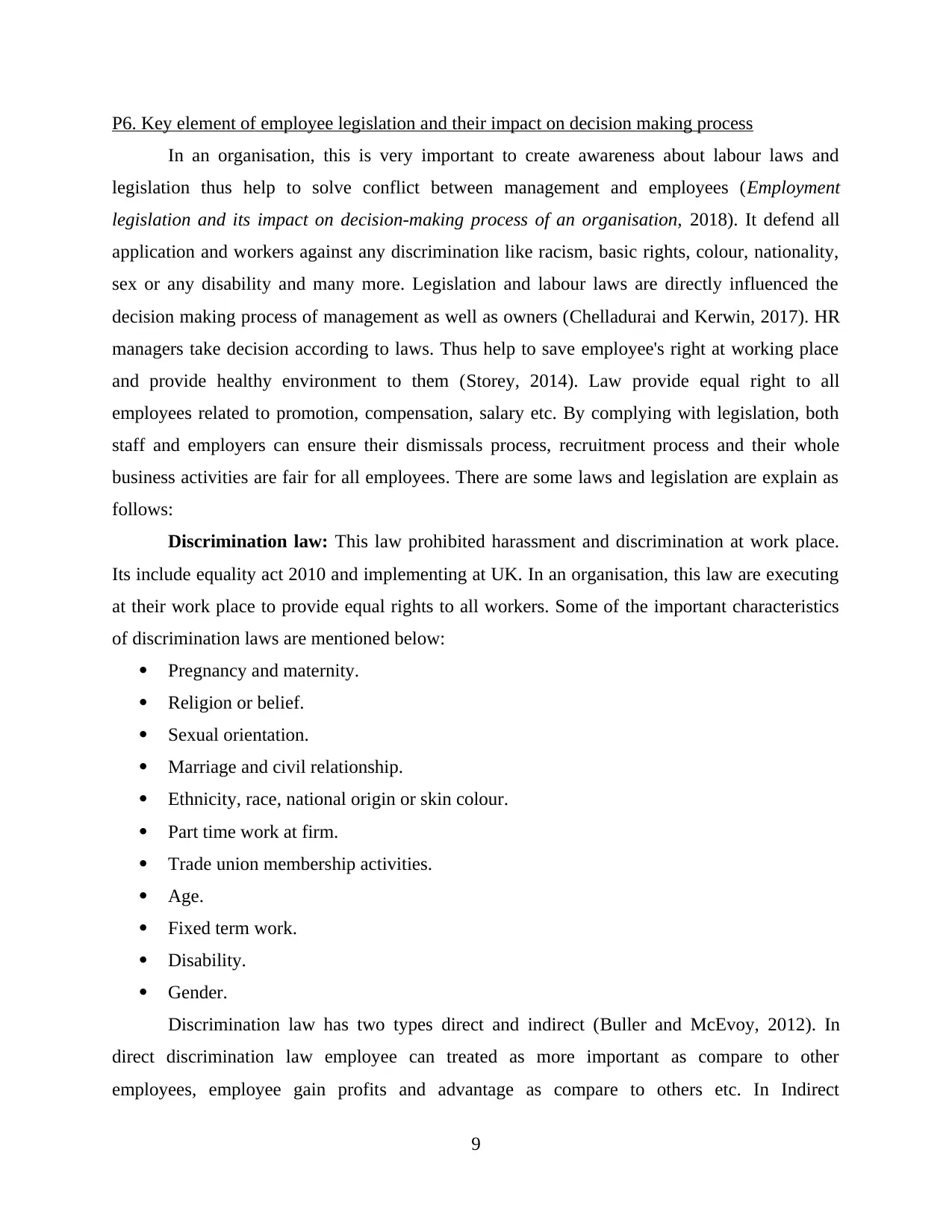
P6. Key element of employee legislation and their impact on decision making process
In an organisation, this is very important to create awareness about labour laws and
legislation thus help to solve conflict between management and employees (Employment
legislation and its impact on decision-making process of an organisation, 2018). It defend all
application and workers against any discrimination like racism, basic rights, colour, nationality,
sex or any disability and many more. Legislation and labour laws are directly influenced the
decision making process of management as well as owners (Chelladurai and Kerwin, 2017). HR
managers take decision according to laws. Thus help to save employee's right at working place
and provide healthy environment to them (Storey, 2014). Law provide equal right to all
employees related to promotion, compensation, salary etc. By complying with legislation, both
staff and employers can ensure their dismissals process, recruitment process and their whole
business activities are fair for all employees. There are some laws and legislation are explain as
follows:
Discrimination law: This law prohibited harassment and discrimination at work place.
Its include equality act 2010 and implementing at UK. In an organisation, this law are executing
at their work place to provide equal rights to all workers. Some of the important characteristics
of discrimination laws are mentioned below:
Pregnancy and maternity.
Religion or belief.
Sexual orientation.
Marriage and civil relationship.
Ethnicity, race, national origin or skin colour.
Part time work at firm.
Trade union membership activities.
Age.
Fixed term work.
Disability.
Gender.
Discrimination law has two types direct and indirect (Buller and McEvoy, 2012). In
direct discrimination law employee can treated as more important as compare to other
employees, employee gain profits and advantage as compare to others etc. In Indirect
9
In an organisation, this is very important to create awareness about labour laws and
legislation thus help to solve conflict between management and employees (Employment
legislation and its impact on decision-making process of an organisation, 2018). It defend all
application and workers against any discrimination like racism, basic rights, colour, nationality,
sex or any disability and many more. Legislation and labour laws are directly influenced the
decision making process of management as well as owners (Chelladurai and Kerwin, 2017). HR
managers take decision according to laws. Thus help to save employee's right at working place
and provide healthy environment to them (Storey, 2014). Law provide equal right to all
employees related to promotion, compensation, salary etc. By complying with legislation, both
staff and employers can ensure their dismissals process, recruitment process and their whole
business activities are fair for all employees. There are some laws and legislation are explain as
follows:
Discrimination law: This law prohibited harassment and discrimination at work place.
Its include equality act 2010 and implementing at UK. In an organisation, this law are executing
at their work place to provide equal rights to all workers. Some of the important characteristics
of discrimination laws are mentioned below:
Pregnancy and maternity.
Religion or belief.
Sexual orientation.
Marriage and civil relationship.
Ethnicity, race, national origin or skin colour.
Part time work at firm.
Trade union membership activities.
Age.
Fixed term work.
Disability.
Gender.
Discrimination law has two types direct and indirect (Buller and McEvoy, 2012). In
direct discrimination law employee can treated as more important as compare to other
employees, employee gain profits and advantage as compare to others etc. In Indirect
9
⊘ This is a preview!⊘
Do you want full access?
Subscribe today to unlock all pages.

Trusted by 1+ million students worldwide
1 out of 18
Related Documents
Your All-in-One AI-Powered Toolkit for Academic Success.
+13062052269
info@desklib.com
Available 24*7 on WhatsApp / Email
![[object Object]](/_next/static/media/star-bottom.7253800d.svg)
Unlock your academic potential
Copyright © 2020–2025 A2Z Services. All Rights Reserved. Developed and managed by ZUCOL.





